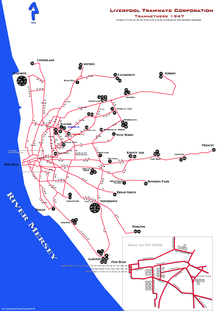Liverpool Corporation Tramways
4 ft 8+1⁄2 in)
Liverpool Corporation Tramways operated a tramway service in Liverpool between 1898 and 1957.[1]
At the peak of Britain’s first-generation tramways, it was possible to travel by tram all the way from Pier Head at Liverpool to the Pennines in Rochdale by tram.
History


In 1897, Liverpool Corporation bought the Liverpool United Tramway and Omnibus Company and obtained a Private Act of Parliament, the Liverpool Corporation Tramways Act 1897.[3]
A modernisation scheme followed immediately with electrification of services taking around 5 years.
The first electric service left Dingle on 16 November 1898. By 1901, the 101 million passengers were carried by the electric tramcars.
The last tram
The last tram, (Car 293 No. 6A), ran from Liverpool's Pier Head to Bowring Park on 14 September 1957.
The car was bought by the Seashore Trolley Museum of Kennebunkport, Maine, U.S. and shipped via Boston, Massachusetts in 1958. As of 2017, it is currently at the back of a shed at the Museum, and in poor condition.
Surviving trams

Horse car 43 is a static exhibit at the Wirral Transport Museum in Birkenhead.
Car 293 survives at the Seashore Trolley Museum in Kennebunkport, Maine, United States of America.
Car 245 was restored to operational condition in 2014, by members of the Merseyside Tramway Preservation Society at the Wirral Transport Museum in Birkenhead,[4] and is operational at the Wirral Tramway.
Car 762 is operational at the Wirral Tramway.
Car 869 (known as a "Streamliner" or "Liner" in original Liverpool service, and "Green Goddess" in later Glasgow service) is part of the operational fleet at the National Tramway Museum at Crich in Derbyshire.
References
- ^ The Golden Age of Tramways. Published by Taylor and Francis.
- ^ Waller, Peter (7 November 2022). Lost Tramways of England: Bolton, SLT, Wigan & St Helens: 15. Graffeg Limited. ISBN 978-1-80258-225-3.
- ^ Munro, S. Alasdair (1967). "Tramway Companies in Liverpool, 1859-1897" (PDF). Transactions of the Historic Society of Lancashire and Cheshire. 119: 207.
- ^ "Liverpool No.245 Restoration Progress Report" (PDF). mtps.co.uk. Retrieved 22 June 2015.
Further reading
- The Leaving of Liverpool (2021) Martin Jenkins and Charles Roberts

- v
- t
- e
- Aberdare
- Barmouth Junction & Arthog
- Cardiff Corporation
- Cardiff Company
- Cardiff District and Penarth Harbour
- Fairbourne
- Glyn Valley
- Great Orme
- Harlech
- Llandudno & Colwyn Bay
- Llanelly
- Llanelly and District Electric
- Merthyr Tydfil
- Neath & District
- Neath Corporation
- Newport Company
- Newport Corporation
- Oystermouth
- Pontypridd and Rhondda Valley
- Pontypridd Urban District
- Pwllheli & Llanbedrog
- Pwllheli Corporation
- Rhondda
- Swansea & Mumbles
- Swansea Improvements
- Swansea Constitution Hill Incline
- Wrexham District
- Wrexham & District Electric
- Aberdeen District
- Aberdeen Corporation
- Aberdeen Suburban
- Airdrie & Coatbridge
- Ayr
- Carstairs House
- Cruden Bay Hotel
- Dumbarton
- Dundee & District
- Dundee Corporation
- Dundee, Broughty Ferry & District
- Dunfermline
- Edinburgh Street
- Edinburgh & District
- Edinburgh Northern
- Edinburgh Corporation
- Falkirk
- Glasgow Company
- Glasgow Corporation
- Glasgow & Ibrox
- Greenock & Port Glasgow
- Inchture
- Kilmarnock
- Kirkcaldy
- Lanarkshire
- Leith
- Musselburgh
- Paisley
- Paisley District
- Perth & District
- Perth Corporation
- Rothesay & Ettrick Bay
- Stirling & Bridge of Allan
- Vale of Clyde
- Wemyss
- Scottish Tramway and Transport Society
and suppliers
- British Thompson-Houston
- Brush Electrical Engineering Company
- Dick, Kerr & Co.
- Electric Railway and Tramway Carriage Works
- English Electric
- Thomas Green & Son
- Hurst Nelson
- Kitson and Company
- Lancaster Carriage and Wagon Works
- Maley & Taunton
- Manlove, Alliott & Co. Ltd.
- Merryweather & Sons
- Midland Railway Carriage and Wagon Company
- G.F. Milnes & Co.
- Milnes Voss
- Starbuck Car and Wagon Company
- United Electric Car Company
- William Wilkinson
companies
- Balfour Beatty
- Birmingham and Midland Tramways Joint Committee
- British Electric Traction
- British Thomson-Houston
- National Electric Construction Company
- New General Traction Company
- Imperial Tramways Company
- Patent Cable Tramways Corporation
- Provincial Tramways Company












